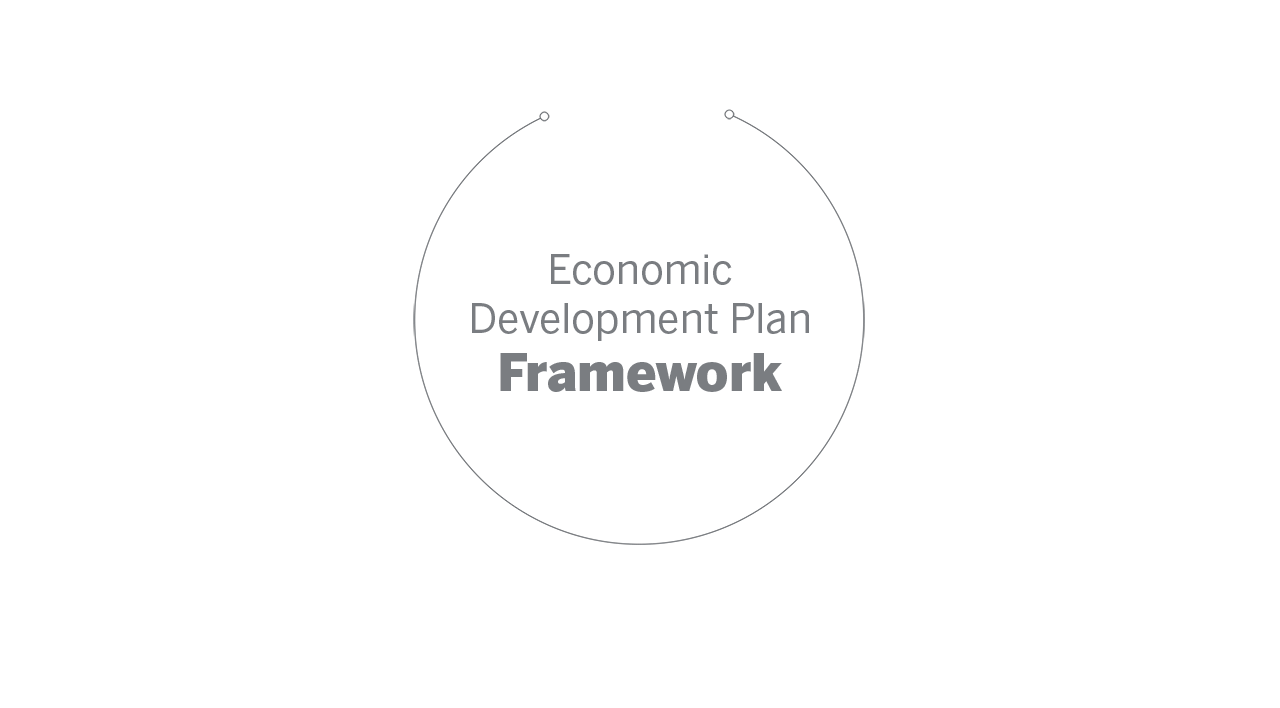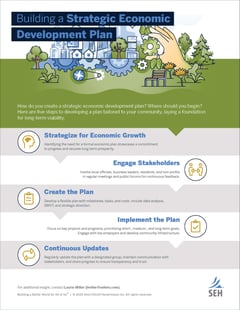Strategic economic development plans are essential for achieving sustainable economic growth and enhancing quality of life. A formal plan allows communities to control their economic development, set clear objectives, and design policies to achieve them. Without a plan, the economic future becomes unpredictable and reactive.
But how do you create a strategic economic development plan? Where should you begin? Here are five steps to developing a plan tailored to your community, laying a foundation for long-term viability.
1. Recognizing When it’s Time to Strategize for Economic Growth
Identifying the need for a formal economic plan showcases a commitment to progress and secures long-term prosperity. Here are some indicators that your community could benefit from a comprehensive economic development strategy:
- A Quiet Downtown After Hours: If your town’s streets are empty after 5 PM and the downtown area lacks vitality, it may be time to attract businesses, events, and activities that energize the local economy.
- An Aging Workforce: When your talent pool is retiring faster than it’s being replenished, a strategic approach is needed to attract and retain younger generations.
- Vacant Storefronts and Underutilized Spaces: A prevalence of "For Sale" signs signals the need for a fresh vision to encourage investment and bring new businesses into the area.
- A Reactive Approach to Challenges: If decision-making feels disjointed or purely reactive, a cohesive plan can align stakeholders and provide clear direction for the future.
- Frequent Community Complaints: An influx of concerns about infrastructure, job opportunities, or other issues highlights the need for structured solutions and proactive planning.
These are not the only indicators to take into consideration but can give you a good start to your plan. By recognizing these signs and acting decisively, you can pave the way for long-term prosperity and a vibrant, resilient community.
2. Foster Continuous Stakeholder Engagement
Recognizing the need for an economic development plan is just the first step, now comes the real work. Building a thriving community requires more than just a plan; it demands collaboration. To turn vision into reality, you need to bring the right people to the table and keep them engaged throughout the process.
Assemble a diverse team of 6 -12 key stakeholders, including local officials, business leaders, residents, and representatives from non-profits and workforce development agencies. Regular meetings, workshops, and public forums should be established to ensure ongoing engagement and feedback. This builds trust and ensures the plan remains responsive to community needs. When engaging with these stakeholders, consider discussing:
- Community Needs and Priorities: Understanding what the community values and needs. This can involve surveys, town hall meetings, and direct dialogues with various community groups to gather a view of the issues that matter most to residents and businesses.
- Project Goals and Objectives: Clearly outlining what the plan aims to achieve. Define specific, measurable outcomes such as job creation targets, infrastructure improvements, or education and training programs to support local workforce development.
- Potential Impacts: How the plan will affect different stakeholders. Evaluate the social, economic, and environmental impacts of proposed initiatives, ensuring that they contribute to sustainable growth and address any potential negative effects on vulnerable populations.
- Feedback Mechanisms: Providing ways for stakeholders to give input and feedback. Establish multiple channels for feedback, including online platforms, suggestion boxes, and periodic review sessions to ensure continuous improvement and responsiveness to community concerns.
- Communication Channels: Ensuring stakeholders know how and when they will be updated. Develop a comprehensive communication strategy that includes regular newsletters, social media updates, and public announcements to keep everyone informed about the progress and milestones of the economic development plan.
By fostering collaboration, transparency, and active engagement, this inclusive approach ensures the economic development plan not only reflects the community's vision but also builds the trust and momentum needed for meaningful and lasting impact.
3. Develop your Plan
Here is where those plans take shape! With input from your team and the community, it's time to transition from collaboration to creation, crafting a plan that serves as a roadmap for your economic goals. Begin with a fluid plan that includes milestones, tasks, deadlines, and costs. Understand the different types of plans: strategic economic development plans (3-5 years), capital improvements plans (5-10 years), and comprehensive plans (10-20 years). Your plan should include economic and demographic data, SWOT analysis, strategic direction, evaluation framework, and workforce development strategies. Avoid detailed zoning regulations, specific capital projects, and operational budgets in your strategic plan.
Economic Development Plan Framework

As you create your plan, it’s important to keep in mind these six factors:
- Weigh economic and demographic data from research, analysis, and forecasting – similar to an investor in the stock market.
- Rely on the natural assets of your community in order to develop realistic goals for economic development.
- Make sure you know your community as a product – this includes its past, present, and forecasted future.
- Recognize your strengths, opportunities, weaknesses, and potential threats – these can have a substantial impact on the success of your plan.
- Gain an understanding of future market trends and industry advances.
- Combine your research and analysis with public input and dialogue. Remember, this is a community effort; success requires buy-in, support, and feedback from the people you serve.
Creating a comprehensive economic development plan requires collaboration, in-depth research, strategic vision, and ongoing community engagement. This plan should serve as a dynamic, adaptable tool, reflecting the evolving needs and aspirations of the community while fostering growth, resilience, and a shared vision.
4. Implement Your Plan
The implementation stage is where your strategic vision transforms into tangible action, driving real progress in your community. This phase focuses on executing key projects and programs while aligning resources to prioritize short-, medium-, and long-term goals. By breaking down your plan into actionable steps, you can ensure measurable outcomes and sustained momentum. Examples of how to bring these goals to fruition include:
- Short-term actions might include quick-win initiatives such as creating a business directory, hosting networking events, or publishing an annual economic report card to highlight achievements and areas for improvement.
- Medium-term plans typically involve initiatives that build on short-term successes and lay the groundwork for long-term goals, such as expanding workforce development programs or enhancing public transportation systems.
- Long-term projects could be shown through industrial development, educational improvements, or developing a niche economic district. Examples include engaging with the community's top ten employers to understand their past, present, and future activities, as well as cultivating social, cultural, artistic, and recreational infrastructure or programs. This could entail developing walking and biking trails, preserving nature conservation areas, and creating cultural amenities to enhance community offerings.

By balancing short-term wins, medium-term progress, and long-term vision, a strategic economic development plan can drive sustainable growth, strengthen community connections, and create a thriving future.
5. Keep Your Plan Up to Date
Never. Stop. Updating. Continuous evaluation is essential for developing and maintaining a strategic economic plan. Responsibility for updates should be assigned to a designated group, such as a city council, an economic development committee, or a specialized task force, ensuring accountability and consistency. Incorporating the plan as a standing item on city council meeting agendas or tying it to the work of a committee dedicated to economic development can provide structured oversight.
Frequent communication with stakeholders, such as through quarterly meetings or updates, is vital for keeping the plan aligned with community needs and fostering collaboration. Additionally, sharing progress and updates in a community newsletter or public forum promotes transparency, engages residents, and builds trust.
By incorporating these practices into the process, you ensure the plan remains effective, forward-thinking, and responsive to emerging opportunities and challenges, ultimately driving sustainable growth and resilience in your community.
Whether you’re just getting started or updating your strategic economic development plan, we’re here to help. Reach out to Laurie for expert guidance and discover more tips on how to make real progress.

Download 5 Steps
to kickstart your economic development plan

.png?width=113&name=SEH_Logo_RGB%20(1).png)
